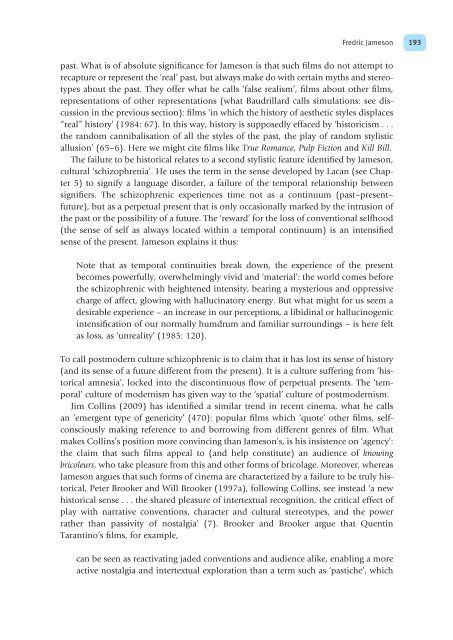Cultural Theory and Popular Culture
Cultural Theory and Popular Culture
Cultural Theory and Popular Culture
You also want an ePaper? Increase the reach of your titles
YUMPU automatically turns print PDFs into web optimized ePapers that Google loves.
Fredric Jameson 193<br />
past. What is of absolute significance for Jameson is that such films do not attempt to<br />
recapture or represent the ‘real’ past, but always make do with certain myths <strong>and</strong> stereotypes<br />
about the past. They offer what he calls ‘false realism’, films about other films,<br />
representations of other representations (what Baudrillard calls simulations: see discussion<br />
in the previous section): films ‘in which the history of aesthetic styles displaces<br />
“real” history’ (1984: 67). In this way, history is supposedly effaced by ‘historicism . . .<br />
the r<strong>and</strong>om cannibalisation of all the styles of the past, the play of r<strong>and</strong>om stylistic<br />
allusion’ (65–6). Here we might cite films like True Romance, Pulp Fiction <strong>and</strong> Kill Bill.<br />
The failure to be historical relates to a second stylistic feature identified by Jameson,<br />
cultural ‘schizophrenia’. He uses the term in the sense developed by Lacan (see Chapter<br />
5) to signify a language disorder, a failure of the temporal relationship between<br />
signifiers. The schizophrenic experiences time not as a continuum (past–present–<br />
future), but as a perpetual present that is only occasionally marked by the intrusion of<br />
the past or the possibility of a future. The ‘reward’ for the loss of conventional selfhood<br />
(the sense of self as always located within a temporal continuum) is an intensified<br />
sense of the present. Jameson explains it thus:<br />
Note that as temporal continuities break down, the experience of the present<br />
becomes powerfully, overwhelmingly vivid <strong>and</strong> ‘material’: the world comes before<br />
the schizophrenic with heightened intensity, bearing a mysterious <strong>and</strong> oppressive<br />
charge of affect, glowing with hallucinatory energy. But what might for us seem a<br />
desirable experience – an increase in our perceptions, a libidinal or hallucinogenic<br />
intensification of our normally humdrum <strong>and</strong> familiar surroundings – is here felt<br />
as loss, as ‘unreality’ (1985: 120).<br />
To call postmodern culture schizophrenic is to claim that it has lost its sense of history<br />
(<strong>and</strong> its sense of a future different from the present). It is a culture suffering from ‘historical<br />
amnesia’, locked into the discontinuous flow of perpetual presents. The ‘temporal’<br />
culture of modernism has given way to the ‘spatial’ culture of postmodernism.<br />
Jim Collins (2009) has identified a similar trend in recent cinema, what he calls<br />
an ‘emergent type of genericity’ (470): popular films which ‘quote’ other films, selfconsciously<br />
making reference to <strong>and</strong> borrowing from different genres of film. What<br />
makes Collins’s position more convincing than Jameson’s, is his insistence on ‘agency’:<br />
the claim that such films appeal to (<strong>and</strong> help constitute) an audience of knowing<br />
bricoleurs, who take pleasure from this <strong>and</strong> other forms of bricolage. Moreover, whereas<br />
Jameson argues that such forms of cinema are characterized by a failure to be truly historical,<br />
Peter Brooker <strong>and</strong> Will Brooker (1997a), following Collins, see instead ‘a new<br />
historical sense . . . the shared pleasure of intertextual recognition, the critical effect of<br />
play with narrative conventions, character <strong>and</strong> cultural stereotypes, <strong>and</strong> the power<br />
rather than passivity of nostalgia’ (7). Brooker <strong>and</strong> Brooker argue that Quentin<br />
Tarantino’s films, for example,<br />
can be seen as reactivating jaded conventions <strong>and</strong> audience alike, enabling a more<br />
active nostalgia <strong>and</strong> intertextual exploration than a term such as ‘pastiche’, which
















